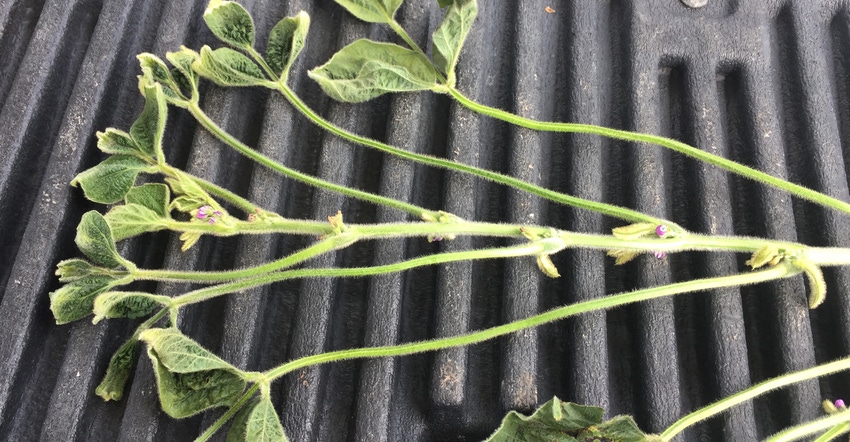December 27, 2017

Every year We get a lot of calls from farmers and retailers, asking, “Can you come look at something with us?” But the 2017 growing season had more than its fair share of field visits.
It got real interesting as we headed through postemerge soybean spraying — attempting to figure out “what happened” with some of the off-target dicamba calls, while also trying to make sound recommendations for more dicamba applications on soybeans. Let’s just say 2017 had a steep learning curve.
I’ll start with a disclaimer: We don’t have precise numbers for off-target dicamba issues. State departments of agriculture reported about 2,700 dicamba-related injury cases to non-dicamba tolerant soybeans and other sensitive plants, with some states reporting historically high numbers.
Chemical companies point out that there were nearly 20 million acres of dicamba soybeans planted (not sure how many were sprayed with dicamba), with no problems for the vast majority of users.
What happened with dicamba drift?
Whatever the actual numbers are, there is room for improvement. So rather than beat up on the dicamba system, I’m hoping we can work toward more success with it. As a weed control tool, it worked well. Last I checked, the soybean weed control tool box needed all the help it could get.
For some off-target dicamba issues in 2017, determining “what happened” was fairly straightforward. There are four primary ways dicamba can move off-target: drift, contamination, inversions and volatilization. The vast majority of issues I dealt with were physical drift tracked back to wind speed or direction. From discussions and information I’ve seen, this seems to be the case with other regions as well.
Drift management is more than about wind. Label language addresses boom height, speed, pressure, proper nozzles and buffer zones to name a few. But if there’s one thing I can have everyone take away from this discussion, it would be about this label change for 2018: Do not apply when wind speeds are greater than 10 mph.
Concerns over inversions mean no spraying in winds less than 3 mph either.
In 2017, the label let us spray in winds up to 15 mph, which may have led to many of the off-target issues. To make sure we are all on the same page, 3 to 10 mph is where we have to be in 2018. It’s going to be tough to get acres covered, but it’s just one of the steps we have to take if we want to have this system in the future.
What else caused dicamba issues?
Sprayer contamination was a culprit in some of our dicamba problems; it doesn’t take much residue in a sprayer to elicit symptoms in sensitive plants. So for 2018, not only does the label tell us how to clean sprayers, but also it gives us record-keeping requirements to follow.
A couple other things come to mind with contamination. It can come from other places than what was in the sprayer; incidents of dicamba contamination from other sources like transfer pumps, minibulk tanks and nurse tanks were reported.
Another issue that may have been a factor is contamination from ammonium sulfate. We use AMS in a lot of herbicide applications; it’s not hard to imagine a little of it accidentally finding a way into a nurse tank or left over from a previous glyphosate application to beans.
Dicamba beans are glyphosate-tolerant, so if a sprayer isn’t cleaned well enough, or doesn’t get cleaned at all, it doesn’t show up on the beans. But AMS can compromise the low volatility improvements of the new dicamba formulations. While incredibly hard to track down or quantify, this could have been a major issue in 2017.
Temperature inversions
Inversions contributed to off target dicamba injury in 2017, too. I won’t go into deep detail on what they are and how to avoid them; you’ll get plenty of that at your dicamba training (see story below). But there were more issues with inversions in 2017 than I expected. Having used a lot of dicamba on corn in my retail years — with only a few times that we saw damage from inversions — I was caught off guard.
Was it the shift to later timing in the season as we used dicamba post in beans? Are we spraying later into the night now with guidance systems and improved lighting? It’s hard to know how much off-target movement came from inversions in 2017, but given the new label language that limits spraying to between sunrise and sunset (and no spraying in winds less than 3 mph), these factors must have been an issue.
How about volatility?
I’m listing volatilization last as a possible cause, partly because the mere mention of the word “volatility” seems to get the chemical companies’ underwear in a bunch, and partly because it probably played the smallest role of the four factors in off-target dicamba injury. Either way, let’s put some context to this to reduce the odds of me having to deal with lawyers from a corporate giant again.
The new dicamba formulations are much less volatile. If they weren’t, my bet is we’d have nailed every susceptible plant in the nation. Company data says they are something like 99% less volatile, and who am I to doubt their science, so we’ll go with it. But, 99% less volatile might leave a little volatility potential though, right?
And if it doesn’t take a lot of dicamba to elicit symptoms on susceptible plants, maybe it was a factor in a few cases. If we go back to the potential for AMS contamination, that may be a more plausible explanation for some cases attributed to volatility. We can expect research will continue.
Training and other fun stuff
Classroom time may not be on the top of everyone’s winter “to do” list, but it’ll be on the list somewhere if you plan on applying any soybean-approved dicamba herbicide product in 2018.
Along with new label language stipulating specific dicamba training, the new dicamba formulations were reclassified as restricted-use products (RUPs). In Iowa, if you plan to apply them, you’ll also need a current private pesticide applicator certification. And if you plan on applying RUP next season, plan on a little mandatory classroom time one way or the other.
We’ll have access to more spray apps to help us stick to label guidelines, including some from the dicamba suppliers themselves. After using a couple different ones in 2017, including an app for predicting temperature inversions in the weather, these apps appear to be good tools.
Nozzles were a hot topic in 2017, too. Although the dicamba websites listed approved nozzles, there were reports of off-label nozzles being used, which were a definite factor in some drift complaints. Double-check that nozzles are on the approved list and in top condition. Hopefully, the planned nozzle give-away programs will help out with any sprayer nozzle updating needed.
Ponder this bit of trivia
There are 4,543 words in the original Constitution, and the Declaration of Independence has 1,458 words. A rough word count of one soybean dicamba label got me somewhere around 5,000;another label was over double that.
It makes me wonder if herbicide label writers are paid by the word. Being familiar with the dicamba labels, I’m pretty sure there is no mention of life, liberty or pursuit of happiness. But the words in those labels are the law. If we follow label instructions, we’ll have much more success keeping dicamba on target next season, and better odds of being allowed to use the dicamba soybean system beyond 2018.
McGrath is the On-Farm Research and Extension coordinator for the Iowa Soybean Research Center at ISU.
About the Author(s)
You May Also Like






